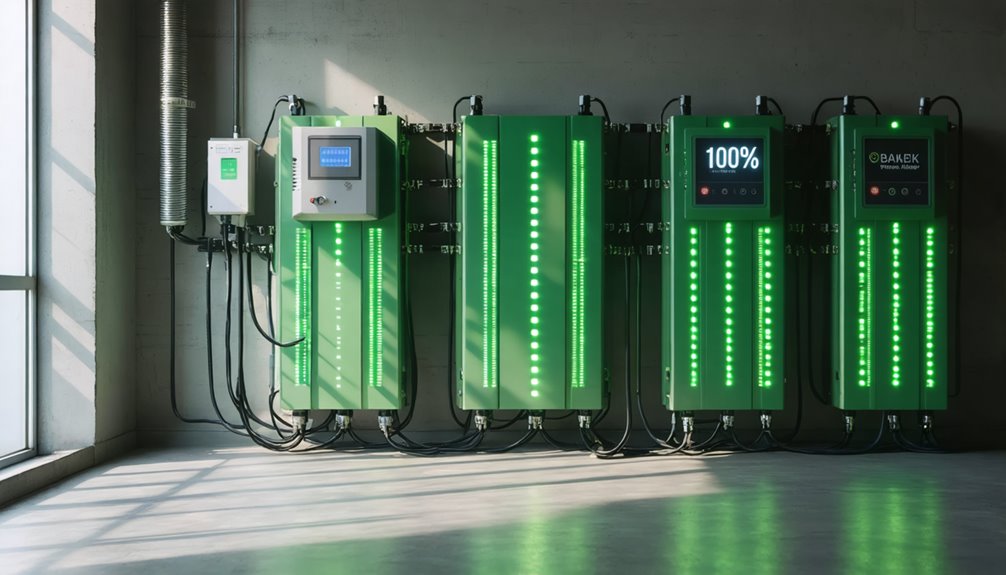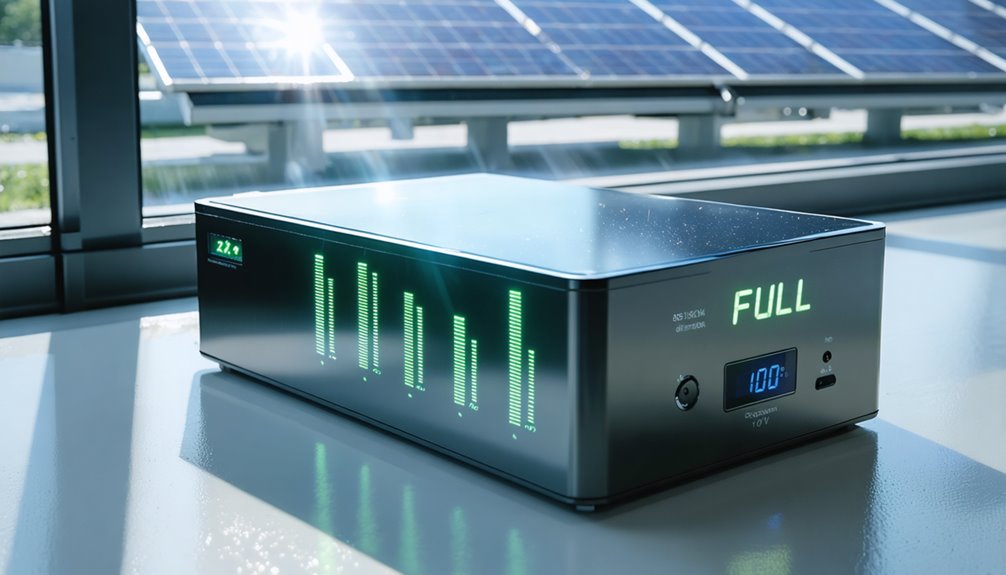You’re watching your solar panels soak up sunlight, but you might wonder how long it’ll take to fill those batteries. The answer isn’t simple it depends on your battery size, panel power, and weather conditions. Most systems need several hours of good sunshine. But here’s what many homeowners don’t realize: once those batteries hit 100%, your expensive solar equipment doesn’t just shut down.
Calculating Solar Battery Charging Time With MPPT Controllers
Most solar battery owners need to know how long it’ll take to charge their batteries using MPPT controllers. You can calculate charging time by dividing the watt-hours you need by your panels’ average power output. MPPT controllers boost efficiency up to 90%, making renewable energy systems more effective.
Here’s an example: If you’re charging a 250Ah, 12V solar battery from 50% capacity, you’ll need about 3,000 watt-hours. With panels generating 319 watts, it’ll take roughly 9 hours. Your daily energy production depends on sun hours too. If you’ve got 355-watt panels getting 5 sun hours, they’ll produce 1,597 watt-hours per day.
These calculations help you understand your system’s performance and plan your renewable energy usage accordingly. Modern systems using lithium-ion batteries typically charge faster than older technologies due to their higher charge acceptance rates and better round-trip efficiency.
Key Factors That Affect Solar Battery Charging Duration
While knowing the basic calculation helps, several factors can markedly change how long it takes to charge your solar battery. Your solar panels’ wattage plays a huge role. Higher wattage means faster charging. A 960-watt system can charge a 48V battery in about 9 hours under perfect conditions.
The type of battery you’re using matters too. Lead-acid batteries charge differently than other types. For instance, lithium-ion batteries typically offer better efficiency and faster charging capabilities compared to lead-acid models. Your location’s sunlight hours also affect charging time. With 5 sun hours, solar power systems generate specific amounts of energy daily.
Don’t forget about efficiency losses. MPPT controllers lose up to 10% of energy during the charging process. This means you’ll need more time than your basic calculations suggest.
Real-World Charging Time Examples for Different Battery Configurations
The numbers tell the real story about solar battery charging times. Your 24V, 250Ah battery bank needs about 3,000 watt-hours to charge from half-full. With solar panels making 1,597 watt-hours daily during five sun hours, you’ll need nearly two days for a complete charge.
Your 48V system with 960-watt panels charges faster. Under perfect conditions, it takes about nine hours. That’s assuming you get maximum sunshine all day.
Here’s what matters: MPPT controllers lose about 10% efficiency. If your panels generate 1,597 watt-hours, only 1,437 actually charge your batteries. These systems work great for powering LED lights overnight.
Once batteries hit full charge, they stop taking power immediately. You’ll need diversion systems to avoid wasting that extra solar energy.
What Happens to Solar Energy When Batteries Reach Full Capacity

When your solar batteries fill up completely, they can’t store any more power from your panels. You’ll need systems to handle the extra energy, like diverting it to run appliances or sending it back to the power grid. Modern solar systems use inverter technology to automatically redirect excess power when battery storage reaches capacity. Without these methods, the surplus electricity your panels make simply goes to waste.
Energy Diversion Methods
Once your solar batteries reach full capacity, they can’t accept any more charge, and that excess energy needs somewhere to go. Energy diversion systems offer a solution to this problem. These systems automatically redirect extra solar power to other uses in your home.
You’ll find these systems can send surplus energy to heat water in your tank. They can also power specific appliances when there’s extra electricity available. Some diversion systems work with smart home technology to turn on devices automatically.
Without these systems, your solar panels might stop producing power altogether. This process, called curtailment, means you’re losing free energy from the sun. Energy diversion prevents this waste by finding productive uses for every bit of power your panels generate.
Grid Feed Systems
Grid feed systems offer another solution for managing excess solar power. When your batteries are full, these systems redirect extra electricity back to the power grid. You’ll see this technology working through net metering programs in many areas.
Your utility company tracks the energy you send to the grid. They’ll often give you credits on your electric bill or pay you for this power. It’s like your solar panels become a mini power plant.
Without grid feed systems, your panels can’t use the extra energy they make. The power just goes to waste. Smart grid technology is making these systems work better. New rules are helping more homeowners connect their solar systems to the grid. This means less wasted energy when your batteries reach capacity.
Preventing Power Waste
Your solar panels keep making electricity even after your batteries fill up completely. When batteries can’t accept more charge, the energy flow stops. This means you’re potentially wasting the power your panels produce.
You’ve got options to prevent this waste. Energy diversion systems can redirect excess power to other uses. Some homeowners send extra electricity to water heaters or connect to the grid. Others use demand response strategies that match energy production with consumption.
Smart grid technologies offer automatic solutions. These systems adjust your energy usage or redirect power when batteries hit capacity. They’ll turn on appliances or send electricity where it’s needed most. Without proper management, you’re losing valuable energy that your panels work hard to create.
Energy Diversion Systems and Overflow Management Solutions
When your solar batteries are full, you’ll need systems to handle the extra power your panels keep making. Diversion load controllers automatically send excess energy to other devices like water heaters or fans instead of wasting it. Grid tie systems let you feed surplus power back to your local utility company, turning your extra energy into credits on your electric bill.
Diversion Load Controllers
Diversion load controllers act like traffic directors for extra solar energy. When your batteries fill up, these smart devices send surplus power to other appliances instead of wasting it. You’ll find DLCs working automatically to prevent battery overcharging while maximizing your solar system’s output.
These controllers let you choose where excess energy goes. You can set them to heat water, run pool pumps, or power other household devices during peak sunlight hours.
| Load Priority | Common Uses | Energy Benefit |
|---|---|---|
| High | Water heaters | Daily hot water |
| High | Pool pumps | Clean pools |
| Medium | Space heaters | Warm rooms |
| Medium | Fans | Cool spaces |
| Low | Backup loads | Emergency use |
DLCs protect your batteries from damage by keeping them within safe charging limits. This extends battery life and saves you money over time.
Grid Tie Systems
After your batteries reach full charge, grid tie systems kick into action by sending extra solar power directly to the utility grid. Your inverter automatically manages this process, preventing energy waste and keeping your system running efficiently.
These smart systems monitor your battery levels in real-time. When they’re full, the extra power flows to your home appliances or back to the grid. You’ll often receive credit from your utility company for this surplus energy.
Modern grid tie technology includes demand response features that match your energy use with solar generation. During peak production times, you can store power or sell it back when rates are highest. Many areas offer regulatory incentives that support these overflow management solutions, making grid tie systems increasingly popular for solar users.
Grid Connection Options for Managing Excess Solar Power
Because solar panels often produce more electricity than you can use or store, grid connection options offer a smart way to handle that extra power. When your batteries are full, you can sell surplus energy back to the power company. This prevents waste and puts money in your pocket.
Net metering lets you earn credits for the extra power you send to the grid. You’ll use these credits to lower your electric bill. Different states have different rules about this system.
Some homeowners combine batteries with grid connections. They’ll store energy for emergencies but still sell extra power. Smart technology now manages this automatically. It decides when to store power, when to use it, and when to sell it to the grid. This combination approach helps maximize your return on investment by ensuring no solar energy goes to waste while maintaining backup power capability.
Optimizing Your Solar System to Prevent Energy Waste
When your solar batteries fill up, energy diversion systems can redirect the extra power to useful tasks around your home. These systems automatically send surplus electricity to water heaters, pool pumps, or other appliances that can use the energy immediately.
You can also prevent waste by adjusting your solar panel angles. Better positioning helps panels capture the right amount of energy, reducing excess power that batteries can’t store.
Demand response strategies match your energy use with solar production. You’ll run high-power appliances when the sun’s shining and batteries are charging.
Some homeowners add extra storage options like thermal systems or pumped hydro storage. These alternatives store surplus energy in different forms, ensuring no power goes to waste when regular batteries reach capacity. For businesses seeking energy cost reduction, optimizing battery charging schedules and overflow management becomes essential for maximizing solar investment returns.
Conclusion
Your solar batteries’ charging time depends on their size, your panels’ power, and available sunlight. Most systems take 4-10 hours to fully charge. When they’re full, your system won’t waste energy. It’ll automatically redirect power to run your home’s appliances, heat water, or send electricity back to the grid. Modern controllers and energy management systems handle this process seamlessly. You’ll maximize your solar investment while avoiding energy waste through these built-in overflow solutions.


